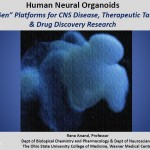
Growing Human Brain on a Petri Dish
In a remarkable feat, Professor Rene Anand of Ohio State University, one of our collaborators from the electric eel genome project, grew near complete human brain organoids on a petri dish in his lab. Here is how the method works. He starts from the skin cells of a person (could be you) and reprograms them into induced pluripotent stem cells (iPSCs) using Yamanaka’s method. Then he grows those stem cells into neural organoid, and you can see your ‘baby brain’ sitting in a test tube. It is truly your brain, because it has the identical genome as yours.
Dr. Anand chose to grow the brains of persons with Alzheimer’s disease and tuberous sclerosis, and noticed something unusual. In his words -
We have discovered that both Alzheimer’s disease (AD) and Tuberous Sclerosis are diseases that result from a massive disruption of the spatial-temporal organization of the human genome within the nucleus.
We are attaching the slides of his recent presentation at the world CNS meeting in Boston along with highlights of the talk. He recently started a company NEURXTEM to help researchers and companies use the brain organoid for clinical research.
You can click on the image to download the slides.

We are pioneers in making nearly complete human neural organoids and this uniquely allows us to comprehensive study the biology of the developing human brain and the etiology of nearly all CNS diseases using “omics” techniques.
A few high lights of my talk:
1. We have discovered that both Alzheimer’s disease (AD) and Tuberous Sclerosis are diseases that result from a massive disruption of the spatial- temporal organization of the human genome within the nucleus. This has profound implications going forward as to how the scientific community will have to tackle autism, AD and cancer.
2. Our data suggests that these complex disorders/diseases arise due to changes in the genome that makes the spatial-temporal expression of genes asynchronous. More than likely, AD is not caused by the accumulation of plaques and tangles, which are grave stone markers, but due to disruption of entire modules of genes whose expression is synchronized through their organization within chromosomes by topology associated domains (TADs) and Lamina associated domains (LADs).
3. In the Tuberous Sclerosis model, we see evidence for how genetic susceptibility x environment interactions can account for the differential susceptibility of individuals to lead toxicity, ascariasis, and a host of other well known clinical problems described in the extensive literature for individuals with autism beyond tuberous sclerosis. We also see a cluster of ~121 tumorogenic genes dysregulated and the most likely cause of the susceptibility of TS patient to tumors on multiple organs including the brain.
4. Similarly, for the first time we see all the four well established pillars of Alzheimer’s disease become visible through the lens of transcriptomics in the PSEN1 model including susceptibility to metal ion toxicity, immune system dysfunction, lipidosis, and decreased longevity. We are still analyzing the entire data set for completion but the results so far are already compelling.
In both models, expression of ~2, 000 out of 13, 000 genes show alterations in their expression levels. All the rest of the genes show<1.5 fold changes in gene expression providing a very nice S/N profile that gives us confidence in the physiological implications of a change in gene expression. In short, we have “digitized” the human brain and this allows us to accurately, efficiently, and exhaustively study disease mechanisms and test drug efficacy, toxicity, and safety in the future.
5. Our neural organoid platform is a) reliable (technical replicates show a variance of <1.5 for 99% of the 15, 000 genes); b) reproducible (independent experiments show variances of <1.5 fold for 98 % of the ~15, 000 genes), and robust (three different iPSCs; normal, TSC2; and PSEN1).
6. These neural organoids are powerful tools for correlating genotype with clinical phenotype and help usher in a new era of personalized medicine in brain disease investigations and also cancer research.
In part (ii), we will present an interview with him and a video of the brain organoid I took, when I visited his lab couple of months back. It is actually a tiny white dot holding the secrets of one’s intelligence and consciousness.